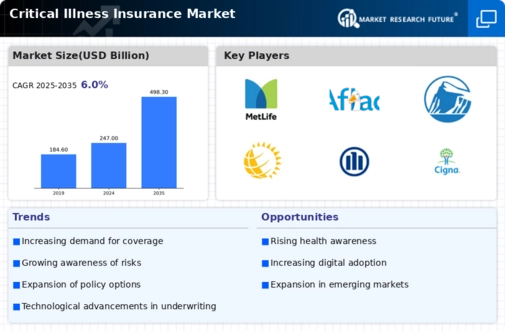-
EXECUTIVE SUMMARY
-
\r\n
-
OVERVIEW 12
- MARKET SYPNOSIS 12
-
\r\n
-
\r\n
-
MARKET INTRODUCTION
-
\r\n
-
SCOPE OF THE STUDY 13
-
\r\n
-
RESEARCH OBJECTIVE 13
-
\r\n
-
LIST OF ASSUMPTIONS 13
-
\r\n
-
RESEARCH METHODOLOGY
-
\r\n
-
OVERVIEW 15
- DATA MINING 15
- SECONDARY RESEARCH 15
- PRIMARY RESEARCH 17
- FORECASTING METHODS 19
- RESEARCH METHODOLOGY FOR MARKET SIZE ESTIMATION 19
- DATA TRIANGULATION 21
- VALIDATION 21
-
\r\n
-
\r\n
-
\r\n
-
\r\n
-
\r\n
-
\r\n
-
\r\n
-
\r\n
-
\r\n
-
\r\n
-
\r\n
-
MARKET DYNAMICS
-
\r\n
-
OVERVIEW 22
-
\r\n
-
DRIVERS 23
- INCREASING CASES OF CRITICAL ILLNESS 23
- INCREASING OUT-OF-POCKET EXPENDITURES FOR INSURED AND UNINSURED POPULATION 23
-
\r\n
-
\r\n
-
\r\n
-
RESTRAINTS 24
- LACK OF AWARENESS ABOUT CRITICAL ILLNESS INSURANCE 24
-
\r\n
-
\r\n
-
OPPORTUNITIES 25
-
\r\n
-
CRITICAL ILLNESS INSURANCE MARKET, BY APPLICATION
-
\r\n
-
OVERVIEW 26
-
\r\n
-
CANCER 27
-
\r\n
-
HEART ATTACK 28
-
\r\n
-
STROKE 28
-
\r\n
-
OTHERS 29
-
\r\n
-
GLOBAL CRITICAL ILLNESS INSURANCE MARKET, BY REGION
-
\r\n
-
OVERVIEW 30
-
\r\n
-
AMERICAS 31
-
\r\n
-
CRITICAL ILLNESS INSURANCE MARKET, BY APPLICATION
-
\r\n
-
\r\n
-
US 33
-
CRITICAL ILLNESS INSURANCE MARKET, BY APPLICATION
-
\r\n
-
\r\n
-
CANADA 33
-
CRITICAL ILLNESS INSURANCE MARKET, BY APPLICATION
-
\r\n
-
\r\n
-
BRAZIL 34
-
CRITICAL ILLNESS INSURANCE MARKET, BY APPLICATION
-
\r\n
-
\r\n
-
MEXICO 34
-
CRITICAL ILLNESS INSURANCE MARKET, BY APPLICATION
-
\r\n
-
\r\n
-
REST OF THE AMERICAS 35
-
CRITICAL ILLNESS INSURANCE MARKET, BY APPLICATION
-
\r\n
-
EUROPE 36
-
\r\n
-
CRITICAL ILLNESS INSURANCE MARKET, BY APPLICATION
-
\r\n
-
\r\n
-
GERMANY 37
-
CRITICAL ILLNESS INSURANCE MARKET, BY APPLICATION
-
\r\n
-
\r\n
-
FRANCE 38
-
CRITICAL ILLNESS INSURANCE MARKET, BY APPLICATION
-
\r\n
-
\r\n
-
SPAIN 38
-
CRITICAL ILLNESS INSURANCE MARKET, BY APPLICATION
-
\r\n
-
\r\n
-
ITALY 39
-
CRITICAL ILLNESS INSURANCE MARKET, BY APPLICATION
-
\r\n
-
\r\n
-
UK 39
-
CRITICAL ILLNESS INSURANCE MARKET, BY APPLICATION
-
\r\n
-
\r\n
-
RUSSIA 40
-
CRITICAL ILLNESS INSURANCE MARKET, BY APPLICATION
-
\r\n
-
\r\n
-
REST OF EUROPE 40
-
CRITICAL ILLNESS INSURANCE MARKET, BY APPLICATION
-
\r\n
-
ASIA-PACIFIC 41
-
\r\n
-
CRITICAL ILLNESS INSURANCE MARKET, BY APPLICATION
-
\r\n
-
\r\n
-
CHINA 42
-
CRITICAL ILLNESS INSURANCE MARKET, BY APPLICATION
-
\r\n
-
\r\n
-
JAPAN 43
-
CRITICAL ILLNESS INSURANCE MARKET, BY APPLICATION
-
\r\n
-
\r\n
-
SOUTH KOREA 43
-
CRITICAL ILLNESS INSURANCE MARKET, BY APPLICATION
-
\r\n
-
\r\n
-
SOUTHEAST ASIA 44
-
CRITICAL ILLNESS INSURANCE MARKET, BY APPLICATION
-
\r\n
-
\r\n
-
AUSTRALIA 44
-
CRITICAL ILLNESS INSURANCE MARKET, BY APPLICATION
-
\r\n
-
\r\n
-
INDIA 45
-
CRITICAL ILLNESS INSURANCE MARKET, BY APPLICATION
-
\r\n
-
\r\n
-
REST OF ASIA-PACIFIC 45
-
CRITICAL ILLNESS INSURANCE MARKET, BY APPLICATION
-
\r\n
-
MIDDLE EAST & AFRICA 46
-
\r\n
-
CRITICAL ILLNESS INSURANCE MARKET, BY APPLICATION
-
\r\n
-
\r\n
-
GCC COUNTRIES 47
-
CRITICAL ILLNESS INSURANCE MARKET, BY APPLICATION
-
\r\n
-
\r\n
-
SOUTH AFRICA 48
-
CRITICAL ILLNESS INSURANCE MARKET, BY APPLICATION
-
\r\n
-
\r\n
-
TURKEY 48
-
CRITICAL ILLNESS INSURANCE MARKET, BY APPLICATION
-
\r\n
-
\r\n
-
EGYPT 49
-
CRITICAL ILLNESS INSURANCE MARKET, BY APPLICATION
-
\r\n
-
\r\n
-
ISRAEL 49
-
CRITICAL ILLNESS INSURANCE MARKET, BY APPLICATION
-
\r\n
-
\r\n
-
REST OF MEA 50
-
CRITICAL ILLNESS INSURANCE MARKET, BY APPLICATION
-
\r\n
-
COMPETITIVE LANDSCAPE
-
\r\n
-
COMPANY MARKET SHARE ANALYSIS 2023 (%) 51
-
\r\n
-
KEY DEVELOPMENTS BY KEY MARKET PLAYERS 51
- PRODUCT LAUNCH 51
- EXPANSION 52
- AGREEMENT & PARTNERSHIP 52
- PRODUCT IMPROVEMENT 53
- ACQUISITION 53
-
\r\n
-
\r\n
-
\r\n
-
\r\n
-
\r\n
-
\r\n
-
COMPANY PROFILES
-
\r\n
-
CHINA LIFE INSURANCE COMPANY 54
- COMPANY OVERVIEW 54
- FINANCIAL OVERVIEW 54
- PRODUCTS/SERVICES OFFERED 55
- KEY DEVELOPMENTS 55
-
\r\n
-
\r\n
-
\r\n
-
\r\n
-
\r\n
-
ALLIANZ 56
- COMPANY OVERVIEW 56
- FINANCIAL OVERVIEW 56
- PRODUCTS/SERVICES OFFERED 57
- KEY DEVELOPMENTS 57
-
\r\n
-
\r\n
-
\r\n
-
\r\n
-
\r\n
-
PING AN INSURANCE 58
- COMPANY OVERVIEW 58
- FINANCIAL OVERVIEW 58
- PRODUCTS/SERVICES OFFERED 59
- KEY DEVELOPMENTS 59
-
\r\n
-
\r\n
-
\r\n
-
\r\n
-
\r\n
-
AVIVA 60
- COMPANY OVERVIEW 60
- FINANCIAL OVERVIEW 60
- PRODUCTS/SERVICES OFFERED 61
- KEY DEVELOPMENTS 61
-
\r\n
-
\r\n
-
\r\n
-
\r\n
-
\r\n
-
PRUDENTIAL 62
- COMPANY OVERVIEW 62
- FINANCIAL OVERVIEW 62
- PRODUCTS/SERVICES OFFERED 63
- KEY DEVELOPMENTS 63
-
\r\n
-
\r\n
-
\r\n
-
\r\n
-
\r\n
-
AEGON 64
- COMPANY OVERVIEW 64
- FINANCIAL OVERVIEW 64
- PRODUCTS/SERVICES OFFERED 65
- KEY DEVELOPMENTS 65
-
\r\n
-
\r\n
-
\r\n
-
\r\n
-
\r\n
-
AXA 66
- COMPANY OVERVIEW 66
- FINANCIAL OVERVIEW 66
- PRODUCTS/SERVICES OFFERED 67
- KEY DEVELOPMENTS 67
-
\r\n
-
\r\n
-
\r\n
-
\r\n
-
\r\n
-
SUN LIFE FINANCIAL 68
- COMPANY OVERVIEW 68
- FINANCIAL OVERVIEW 68
- PRODUCTS/SERVICES OFFERED 69
- KEY DEVELOPMENTS 69
-
\r\n
-
\r\n
-
\r\n
-
\r\n
-
\r\n
-
AFLAC INCORPORATED 70
- COMPANY OVERVIEW 70
- FINANCIAL OVERVIEW 70
- PRODUCTS/SERVICES OFFERED 71
- KEY DEVELOPMENTS 71
-
\r\n
-
\r\n
-
\r\n
-
\r\n
-
\r\n
-
HUAXIA LIFE INSURANCE CO. 72
- COMPANY OVERVIEW 72
- FINANCIAL OVERVIEW 72
- PRODUCTS/SERVICES OFFERED 72
- KEY DEVELOPMENTS 72
-
\r\n
-
\r\n
-
\r\n
-
\r\n
-
\r\n
-
AIG 73
- COMPANY OVERVIEW 73
- FINANCIAL OVERVIEW 73
- PRODUCTS/SERVICES OFFERED 74
- KEY DEVELOPMENTS 74
-
\r\n
-
\r\n
-
\r\n
-
\r\n
-
\r\n
-
METLIFE SERVICES AND SOLUTIONS, LLC 75
- COMPANY OVERVIEW 75
- FINANCIAL OVERVIEW 75
- PRODUCTS/SERVICES OFFERED 76
- KEY DEVELOPMENTS 76
-
\r\n
-
\r\n
-
\r\n
-
\r\n
-
\r\n
-
ZURICH 77
- COMPANY OVERVIEW 77
- FINANCIAL OVERVIEW 77
- PRODUCTS OFFERED 78
- KEY DEVELOPMENTS 78
-
\r\n
-
\r\n
-
\r\n
-
\r\n
-
\r\n
-
STAR UNION DAI-ICHI LIFE INSURANCE (SUD LIFE) 79
- COMPANY OVERVIEW 79
- FINANCIAL OVERVIEW 79
- PRODUCTS OFFERED 79
- KEY DEVELOPMENTS 79
-
\r\n
-
\r\n
-
\r\n
-
\r\n
-
\r\n
-
UNITED HEALTHCARE SERVICES, INC. 80
- COMPANY OVERVIEW 80
- FINANCIAL OVERVIEW 80
- PRODUCTS OFFERED 81
- KEY DEVELOPMENTS 81
-
\r\n
-
\r\n
-
\r\n
-
\r\n
-
\r\n
-
LIBERTY MUTUAL 82
- COMPANY OVERVIEW 82
- FINANCIAL OVERVIEW 82
- PRODUCTS OFFERED 82
- KEY DEVELOPMENTS 82
-
\r\n
-
\r\n
-
\r\n
-
\r\n
-
\r\n
-
APPENDIX
-
\r\n
-
REFERENCES 83
-
\r\n
-
LIST OF TABLES
-
\r\n
-
LIST OF ASSUMPTIONS 13
-
\r\n
-
GLOBAL CRITICAL ILLNESS INSURANCE MARKET, BY APPLICATION, 2024-2032 (USD Billion) 27
-
\r\n
-
GLOBAL CRITICAL ILLNESS INSURANCE MARKET, FOR CANCER, BY REGION, 2024-2032 (USD Billion) 27
-
\r\n
-
GLOBAL CRITICAL ILLNESS INSURANCE MARKET, FOR HEART ATTACK, BY REGION, 2024-2032 (USD Billion) 28
-
\r\n
-
GLOBAL CRITICAL ILLNESS INSURANCE MARKET, FOR STROKE, BY REGION, 2024-2032 (USD Billion) 29
-
\r\n
-
GLOBAL CRITICAL ILLNESS INSURANCE MARKET, FOR OTHERS, BY REGION, 2024-2032 (USD Billion) 29
-
\r\n
-
GLOBAL CRITICAL ILLNESS INSURANCE MARKET, BY REGION, 2024-2032 (USD Billion) 30
-
\r\n
-
AMERICAS: CRITICAL ILLNESS INSURANCE MARKET, BY COUNTRY, 2024-2032 (USD Billion) 32
-
\r\n
-
AMERICAS: CRITICAL ILLNESS INSURANCE MARKET, BY APPLICATION, 2024-2032 (USD Billion) 32
-
\r\n
-
US: CRITICAL ILLNESS INSURANCE MARKET, BY APPLICATION, 2024-2032 (USD Billion) 33
-
\r\n
-
CANADA: CRITICAL ILLNESS INSURANCE MARKET, BY APPLICATION, 2024-2032 (USD Billion) 33
-
\r\n
-
BRAZIL: CRITICAL ILLNESS INSURANCE MARKET, BY APPLICATION, 2024-2032 (USD Billion) 34
-
\r\n
-
MEXICO: CRITICAL ILLNESS INSURANCE MARKET, BY APPLICATION, 2024-2032 (USD Billion) 34
-
\r\n
-
REST OF THE AMERICAS: CRITICAL ILLNESS INSURANCE MARKET, BY APPLICATION, 2024-2032 (USD Billion) 35
-
\r\n
-
EUROPE: CRITICAL ILLNESS INSURANCE MARKET, BY COUNTRY, 2024-2032 (USD Billion) 36
-
\r\n
-
EUROPE: CRITICAL ILLNESS INSURANCE MARKET, BY APPLICATION, 2024-2032 (USD Billion 37
-
\r\n
-
GERMANY: CRITICAL ILLNESS INSURANCE MARKET, BY APPLICATION, 2024-2032 (USD Billion) 37
-
\r\n
-
FRANCE: CRITICAL ILLNESS INSURANCE MARKET, BY APPLICATION, 2024-2032 (USD Billion) 38
-
\r\n
-
SPAIN: CRITICAL ILLNESS INSURANCE MARKET, BY APPLICATION, 2024-2032 (USD Billion) 38
-
\r\n
-
ITALY: CRITICAL ILLNESS INSURANCE MARKET, BY APPLICATION, 2024-2032 (USD Billion) 39
-
\r\n
-
UK: CRITICAL ILLNESS INSURANCE MARKET, BY APPLICATION, 2024-2032 (USD Billion) 39
-
\r\n
-
RUSSIA: CRITICAL ILLNESS INSURANCE MARKET, BY APPLICATION, 2024-2032 (USD Billion) 40
-
\r\n
-
REST OF EUROPE: CRITICAL ILLNESS INSURANCE MARKET, BY APPLICATION, 2024-2032 (USD Billion) 40
-
\r\n
-
ASIA-PACIFIC: CRITICAL ILLNESS INSURANCE MARKET, BY COUNTRY, 2024-2032 (USD Billion) 41
-
\r\n
-
ASIA-PACIFIC: CRITICAL ILLNESS INSURANCE MARKET, BY APPLICATION, 2024-2032 (USD Billion) 42
-
\r\n
-
CHINA: CRITICAL ILLNESS INSURANCE MARKET, BY APPLICATION, 2024-2032 (USD Billion) 42
-
\r\n
-
JAPAN: CRITICAL ILLNESS INSURANCE MARKET, BY APPLICATION, 2024-2032 (USD Billion) 43
-
\r\n
-
SOUTH KOREA: CRITICAL ILLNESS INSURANCE MARKET, BY APPLICATION, 2024-2032 (USD Billion) 43
-
\r\n
-
SOUTHEAST ASIA: CRITICAL ILLNESS INSURANCE MARKET, BY APPLICATION, 2024-2032 (USD Billion) 44
-
\r\n
-
AUSTRALIA: CRITICAL ILLNESS INSURANCE MARKET, BY APPLICATION, 2024-2032 (USD Billion) 44
-
\r\n
-
INDIA: CRITICAL ILLNESS INSURANCE MARKET, BY APPLICATION, 2024-2032 (USD Billion) 45
-
\r\n
-
REST OF ASIA-PACIFIC: CRITICAL ILLNESS INSURANCE MARKET, BY APPLICATION, 2024-2032 (USD Billion) 45
-
\r\n
-
MIDDLE EAST & AFRICA: CRITICAL ILLNESS INSURANCE MARKET, BY COUNTRY, 2024-2032 (USD Billion) 46
-
\r\n
-
MIDDLE EAST & AFRICA: CRITICAL ILLNESS INSURANCE MARKET, BY APPLICATION, 2024-2032 (USD Billion) 47
-
\r\n
-
GCC COUNTRIES: CRITICAL ILLNESS INSURANCE MARKET, BY APPLICATION, 2024-2032 (USD Billion) 47
-
\r\n
-
SOUTH AFRICA: CRITICAL ILLNESS INSURANCE MARKET, BY APPLICATION, 2024-2032 (USD Billion) 48
-
\r\n
-
TURKEY: CRITICAL ILLNESS INSURANCE MARKET, BY APPLICATION, 2024-2032 (USD Billion) 48
-
\r\n
-
EGYPT: CRITICAL ILLNESS INSURANCE MARKET, BY APPLICATION, 2024-2032 (USD Billion) 49
-
\r\n
-
ISRAEL: CRITICAL ILLNESS INSURANCE MARKET, BY APPLICATION, 2024-2032 (USD Billion) 49
-
\r\n
-
REST OF MEA: CRITICAL ILLNESS INSURANCE MARKET, BY APPLICATION, 2024-2032 (USD Billion) 50
-
\r\n
-
PRODUCT LAUNCH 51
-
\r\n
-
EXPANSION 52
-
\r\n
-
AGREEMENT & PARTNERSHIP 52
-
\r\n
-
PRODUCT IMPROVEMENT 53
-
\r\n
-
ACQUISITION 53
-
\r\n
-
CHINA LIFE INSURANCE COMPANY: PRODUCTS/SERVICES OFFERED 55
-
\r\n
-
CHINA LIFE INSURANCE COMPANY: KEY DEVELOPMENTS 55
-
\r\n
-
ALLIANZ: PRODUCTS/SERVICES OFFERED 57
-
\r\n
-
ALLIANZ: KEY DEVELOPMENTS 57
-
\r\n
-
PING AN INSURANCE: PRODUCTS/SERVICES OFFERED 59
-
\r\n
-
AVIVA: PRODUCTS/SERVICES OFFERED 61
-
\r\n
-
AVIVA: KEY DEVELOPMENTS 61
-
\r\n
-
PRUDENTIAL: PRODUCTS/SERVICES OFFERED 63
-
\r\n
-
PRUDENTIAL: KEY DEVELOPMENTS 63
-
\r\n
-
AEGON: PRODUCTS/SERVICES OFFERED 65
-
\r\n
-
AEGON: KEY DEVELOPMENTS 65
-
\r\n
-
AXA: PRODUCTS/SERVICES OFFERED 67
-
\r\n
-
SUN LIFE FINANCIAL: PRODUCTS/SERVICES OFFERED 69
-
\r\n
-
SUN LIFE FINANCIAL: KEY DEVELOPMENTS 69
-
\r\n
-
AFLAC INCORPORATED: PRODUCTS/SERVICES OFFERED 71
-
\r\n
-
AFLAC INCORPORATED: KEY DEVELOPMENTS 71
-
\r\n
-
HUAXIA LIFE INSURANCE CO.: PRODUCTS/SERVICES OFFERED 72
-
\r\n
-
AIG: PRODUCTS/SERVICES OFFERED 74
-
\r\n
-
METLIFE SERVICES AND SOLUTIONS, LLC: PRODUCTS/SERVICES OFFERED 76
-
\r\n
-
ZURICH: PRODUCTS OFFERED 78
-
\r\n
-
STAR UNION DAI-ICHI LIFE INSURANCE: PRODUCTS OFFERED 79
-
\r\n
-
STAR UNION DAI-ICHI LIFE INSURANCE: KEY DEVELOPMENTS 79
-
\r\n
-
UNITED HEALTHCARE SERVICES, INC.: PRODUCTS OFFERED 81
-
\r\n
-
LIBERTY MUTUAL: PRODUCTS OFFERED 82
-
\r\n
-
LIST OF FIGURES
-
\r\n
-
GLOBAL CRITICAL ILLNESS INSURANCE MARKET: MARKET STRUCTURE 14
-
\r\n
-
BOTTOM-UP AND TOP-DOWN APPROACHES 20
-
\r\n
-
MARKET DYNAMICS: ANALYSIS OF THE GLOBAL CRITICAL ILLNESS INSURANCE MARKET 22
-
\r\n
-
DRIVERS IMPACT ANALYSIS 24
-
\r\n
-
RESTRAINTS IMPACT ANALYSIS 25
-
\r\n
-
GLOBAL CRITICAL ILLNESS INSURANCE MARKET SHARE, BY APPLICATION, 2023 (%) 26
-
\r\n
-
GLOBAL CRITICAL ILLNESS INSURANCE MARKET, BY APPLICATION, 2022 & 2030 (USD Billion) 26
-
\r\n
-
GLOBAL CRITICAL ILLNESS INSURANCE MARKET SHARE, BY REGION, 2023 (%) 30
-
\r\n
-
AMERICAS: CRITICAL ILLNESS INSURANCE MARKET SHARE, BY COUNTRY, 2023 (%) 31
-
\r\n
-
EUROPE: CRITICAL ILLNESS INSURANCE MARKET SHARE, BY COUNTRY, 2023 (%) 36
-
\r\n
-
ASIA-PACIFIC: CRITICAL ILLNESS INSURANCE MARKET SHARE, BY COUNTRY, 2023 (%) 41
-
\r\n
-
MIDDLE EAST & AFRICA: CRITICAL ILLNESS INSURANCE MARKET SHARE, BY COUNTRY, 2023 (%) 46
-
\r\n
-
CHINA LIFE INSURANCE COMPANY: FINANCIAL OVERVIEW SNAPSHOT 54
-
\r\n
-
ALLIANZ: FINANCIAL OVERVIEW SNAPSHOT 56
-
\r\n
-
PING AN INSURANCE: FINANCIAL OVERVIEW SNAPSHOT 58
-
\r\n
-
AVIVA: FINANCIAL OVERVIEW SNAPSHOT 60
-
\r\n
-
PRUDENTIAL: FINANCIAL OVERVIEW SNAPSHOT 62
-
\r\n
-
AEGON: FINANCIAL OVERVIEW SNAPSHOT 64
-
\r\n
-
AXA: FINANCIAL OVERVIEW SNAPSHOT 66
-
\r\n
-
SUN LIFE FINANCIAL: FINANCIAL OVERVIEW 68
-
\r\n
-
AFLAC INCORPORATED: FINANCIAL OVERVIEW SNAPSHOT 70
-
\r\n
-
AIG: FINANCIAL OVERVIEW SNAPSHOT 73
-
\r\n
-
METLIFE SERVICES AND SOLUTIONS, LLC: FINANCIAL OVERVIEW SNAPSHOT 75
-
\r\n
-
ZURICH: FINANCIAL OVERVIEW SNAPSHOT 77
-
\r\n
-
UNITED HEALTHCARE SERVICES, INC.: FINANCIAL OVERVIEW SNAPSHOT 80
-
\r\n
-
LIBERTY MUTUAL: FINANCIAL OVERVIEW SNAPSHOT 82
-
"









Leave a Comment